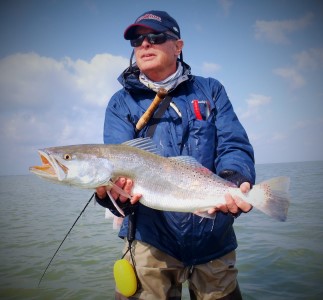Virginia Game Fish Tagging Program honors top taggers
The Virginia Game Fish Tagging Program (VGFTP) celebrated the achievements of its top volunteers with the help of Bass Pro Shops in Hampton Friday night. A cooperative effort between the Marine Advisory Program at the Virginia Institute of Marine Science (VIMS) and the Virginia Saltwater Tournament at the Virginia Marine Resources Commission (VMRC), the VGFTP uses state saltwater license funds to train volunteer anglers to tag recreationally important finfishes. Data collected by the VGFTP helps anglers and managers learn more about fish migration, growth and habitat use. In 2021, VGFTP volunteers tagged more than 19,160 fishes and recorded 1,473 recaptures.
Hoisting the Top Tagger trophy again this year was Yorktown angler, Ed Shepherd, who tagged more than 6,000 fishes in 2021. In addition to individual species’ categories, the tagging program introduced some new awards to celebrate the longest-standing volunteers, fish diversity in tagging, and use of experimental tags. Award winners hailed from all over Virginia and the Eastern Shore.
Since 1995, VGFTP anglers have tagged more than 385,000 fishes and contributed vital data for the management of these marine species.
For more information about the Virginia Game Fish Tagging Program, visit www.vims.edu/vgftp/ .
When most people catch a fish that is too small to keep, they let it go and never know its subsequent fate. But Sheldon Arey, a volunteer with the Virginia Game Fish Tagging Program, now knows exactly what happened to the 26-inch-long cobia that he caught and tagged on June 25, 2009 at Latimer Shoal near Kiptopeke State Park.
That's because the same cobia was recaptured at the York Spit on May 27, 2019 by Alison Temple. In the 3,623 days since Arey first tagged it—a span of 9 years, 11 months, and 3 days—the fish had more than doubled in size to 53 inches total length.  The recapture sets a new “days at large” record for the tagging program, beating the former record from a tautog that had been at large for 3,411 days. Fisheries scientists define "days at large" as the number of days between the first time a fish is tagged and released and its most recent recapture.
The recapture sets a new “days at large” record for the tagging program, beating the former record from a tautog that had been at large for 3,411 days. Fisheries scientists define "days at large" as the number of days between the first time a fish is tagged and released and its most recent recapture.
 Susanna Musick, marine recreation specialist at the Virginia Institute of Marine Science and VGFTP co-coordinator, says “We're really lucky to have dedicated volunteers like Sheldon and thoughtful anglers like Alison who collect and report data for our recreationally important finfish species. Long-term recaptures like Sheldon’s cobia are important sources of data that can reflect overall patterns of migration and site fidelity.”
Susanna Musick, marine recreation specialist at the Virginia Institute of Marine Science and VGFTP co-coordinator, says “We're really lucky to have dedicated volunteers like Sheldon and thoughtful anglers like Alison who collect and report data for our recreationally important finfish species. Long-term recaptures like Sheldon’s cobia are important sources of data that can reflect overall patterns of migration and site fidelity.”
 Cobia are a favorite of anglers in the Chesapeake Bay and elsewhere, known as an excellent eating fish and an energetic fighter on the line. They can attain a weight exceeding 100 pounds. Data from the VGFTP and other tagging programs show that cobia visit the lower Chesapeake Bay during the summer and migrate into offshore waters in the fall, some traveling as far south as the Florida Keys. Of the cobia tagged in Virginia, 86% are recaptured in state waters.
Cobia are a favorite of anglers in the Chesapeake Bay and elsewhere, known as an excellent eating fish and an energetic fighter on the line. They can attain a weight exceeding 100 pounds. Data from the VGFTP and other tagging programs show that cobia visit the lower Chesapeake Bay during the summer and migrate into offshore waters in the fall, some traveling as far south as the Florida Keys. Of the cobia tagged in Virginia, 86% are recaptured in state waters.
For anglers targeting cobia in Virginia this summer, Musick notes that the record-breaking tagged fish was released. "So that means it's still out there," she says, "waiting to be caught again and beat its own record!"
VGFTP
Established in 1995, the Virginia Game Fish Tagging Program uses a trained cadre of 200 volunteer anglers to gather data on year-to-year abundance, habitat use, and seasonal migration patterns for selected species of recreationally popular marine fishes.  Through 2018, the program’s database included 320,617 tag records and approximately 33,693 recapture records, with fishing efforts documented at more than 900 locations in Virginia waters.
Through 2018, the program’s database included 320,617 tag records and approximately 33,693 recapture records, with fishing efforts documented at more than 900 locations in Virginia waters.
A cooperative effort between the Marine Advisory Program at the Virginia Institute of Marine Science and the Virginia Marine Resources Commission's Saltwater Tournament, the program’s funding is from state saltwater license funds and VIMS.

